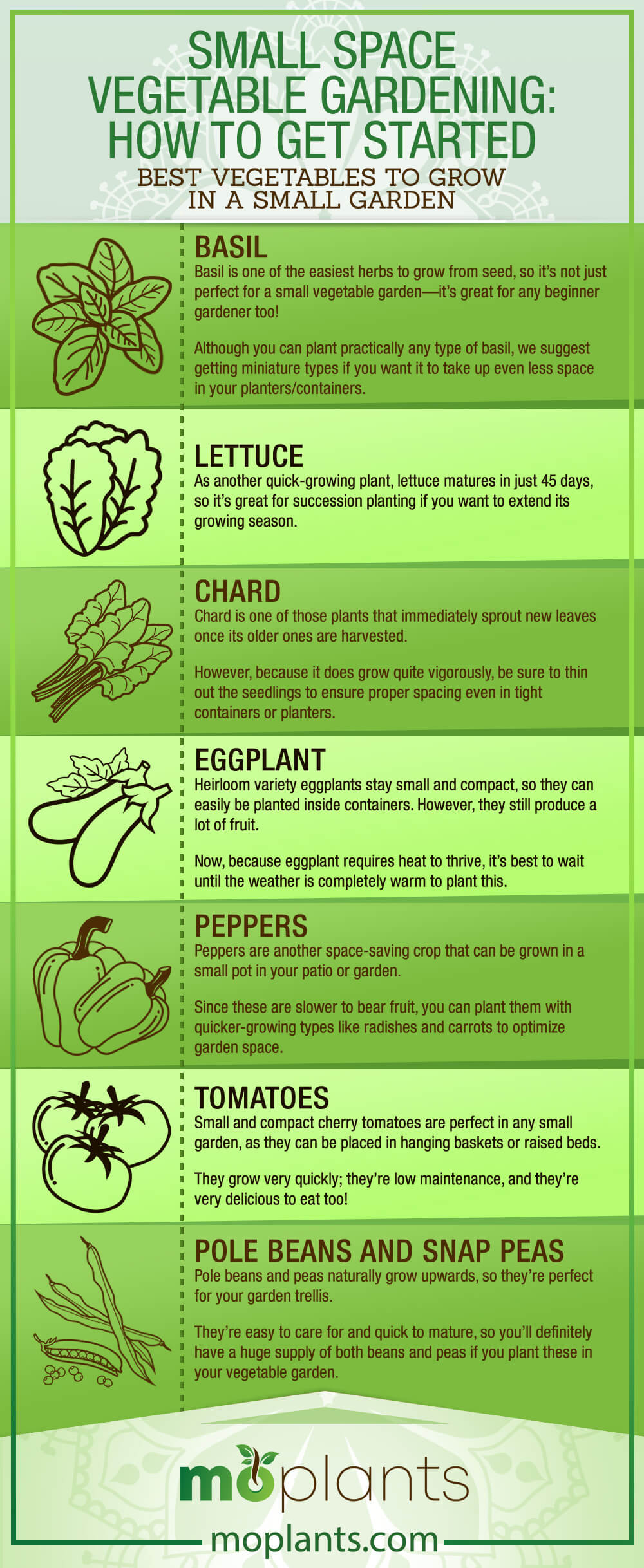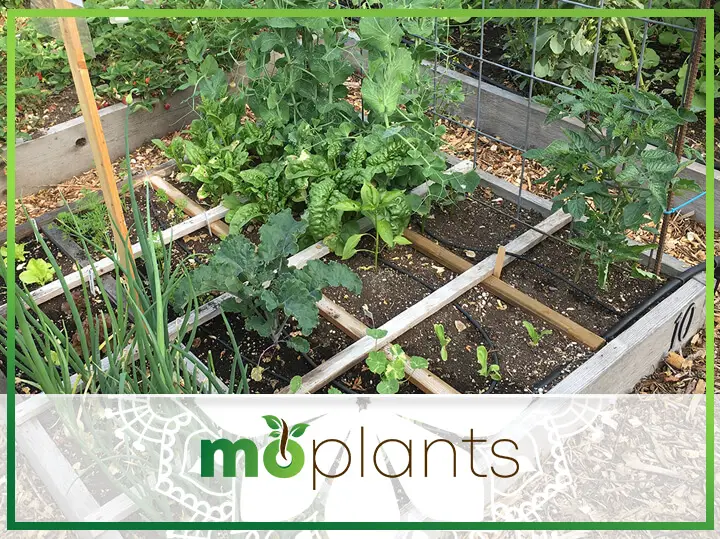Working with little to no garden space? The good news is, you don’t need too much ground space for growing vegetables.
If you have soil, seeds, and a place to put your plants in, you can start gardening right away!
Caring for your crops all throughout the growing season will take time and effort, but once it’s time to harvest, you’ll have plenty of good food for you and your family to eat.
Sounds good? Let’s get started!
Setting Up Your Small Vegetable Garden
Every gardener should have a plan before planting anything. If you don’t spend a lot of time gardening, growing vegetables will definitely be a little bit of a challenge, so it’s best to be organized from the get-go.
Here are some ideas, information, and tips on how to effectively and efficiently set up your small garden.
Knowing Your Garden Site
Location is everything. Vegetables don’t grow the same way in different parts of the country due to varying weather conditions, soil, and other natural factors.
Thus, you should know what your living conditions are like so you can choose the right plants and adjust your gardening style, if necessary.
Among all the different variables that could affect your plants, these three stand out:
Sun
Most varieties of vegetables need full sun exposure to flourish, as this encourages them to produce fruits.
Now, this isn’t a problem in country gardens, but if you live in a building or in an area that doesn’t receive much sunlight, you should opt to grow leafy greens— these do well even in the shade.
Soil
No matter the type of plant you’re trying to grow, you need to have good, rich, nutrient-dense soil for optimal results.
Many people use a combination of natural compost, fertilizer, and good quality soil in their gardens to ensure plants emerge strong and healthy.
If you’re using a small plot on the ground and you find that your soil isn’t so nice, you can always add organic matter to enrich it.
Water
Regular watering is a must if you want your crops to thrive. If you’re not getting a lot of rain during summer months, it’s even more important to give your plants the hydration they need!
If you have the means, consider investing in a drip irrigation system. Since this directly waters the roots, it’s more effective and less prone to wastage too.
Just make sure you have a good drainage system in place, as you don’t want to overwater your plants!
Maximizing Your Available Space
How much space are you working with? Different garden layouts suit different types of areas, so pick the one that’s most suitable for you. Here are some ideas for small spaces:
Container Gardens
If you can’t grow on the ground, the next best thing is to plant in pots or containers! You can repurpose almost anything to serve as container space as long as it’s big enough to hold the crops as they mature.
When picking a plant for your containers, make sure to choose patio or dwarf varieties, as these are meant for small spaces.
You’ll also need to water your plants thoroughly, as they can’t dry out. Just make sure the containers still drain well to prevent root rot.
Raised Beds
If you have a little more space, you can grow vegetables in a raised bed.
For some gardeners, these are actually better than planting straight on the ground because you can control the soil you use. Plus, since they’re positioned higher, it’s much easier to water and care for the plants.
Just make sure the garden bed is deep enough to hold a lot of soil since plant roots can grow very long.
Like with container gardens, have an effective drainage system in place to prevent overwatering.
Vertical Gardens
Growing vertically saves a lot of space, so this is a great option for city gardeners. A vertical garden can serve as a practical design element too!
While you can certainly utilize any existing fencing you have, you can also choose to buy arbors, trellises, and hanging baskets, among others, depending on the garden aesthetic you want.
If you’re crafty, you can even make these yourselves by repurposing stepladders, woven baskets, crates, or any other sturdy, stackable materials.
Choosing the Right Plants
Because you only have a small space for your vegetable garden, you have to make some tough choices.
Plan ahead and prioritize the fruits and vegetables you know you’ll consume a lot of.
We know there are plenty of interesting varieties to choose from, but a high yield isn’t always a good thing if most of it is going to waste.
Of course, you should also pick the plants that grow best in the conditions you live in as well.
You might love tomatoes and peppers, but if you know they’ll be left in the shade, you’ll be better off planting vegetables that don’t actually need much sun.
Planting Techniques
Even in a small garden, though, you can utilize plenty of planting techniques to maximize your yield. Here are some tips for a successful growing season!
Use Companion Plants
Companion plants grow well together and conserve space in your garden because they have a similar growth habit.
When planted near each other, these crops also help with pest management and pollination. Most importantly, though, they increase your yield, so you’ll end up with more food on your table!
For example, sugar snap peas and pole beans go together because the latter starts to mature just when the former is spent. The trick is to pair quick-growing vegetables with ones that take longer to harvest.
Another option is to plant varieties that grow to different heights. For instance, heat-loving tomatoes will shade basil herbs, which prefer cooler temperatures.
Other popular companion planting combinations include radishes and carrots as well as tomatoes and eggplants.
Interplant Flowers
Flowers improve the overall aesthetic of your garden, but they have many practical uses too.
First of all, flowers attract pollinators, which helps your crops produce more fruit.
Next, if you’re having pest-related problems, flowers can help too! Marigolds, in particular, are known for repelling whiteflies and many other destructive insects from your garden.
Try Succession Planting
Another one of our tips is to try out succession planting. If you only have a small space for your garden, this ensures you get to enjoy the fruits of your labor all throughout the growing season.
All you have to do is re-seed quick-growing plant varieties in your vegetable garden every two to three weeks.
When the older plants exhaust themselves producing, you’ll have new ones bearing fruits and flowers in no time!
Harvest Regularly
Did you know that if you harvest regularly, your plant is encouraged to produce more?
Lettuce, chard, kale, and some other herbs are among the most prolific varieties in your garden, especially when you consistently trim back their outer leaves.
Best Vegetables to Grow In a Small Garden
Now that you know our vegetable gardening tips for small spaces, it’s time to plan out the types of vegetables you want to grow in your garden!
Basil
Basil is one of the easiest herbs to grow from seed, so it’s not just perfect for a small vegetable garden—it’s great for any beginner gardener too!
Although you can plant practically any type of basil, we suggest getting miniature types if you want it to take up even less space in your planters/containers.
Lettuce
As another quick-growing plant, lettuce matures in just 45 days, so it’s great for succession planting if you want to extend its growing season.
Because there are so many types to choose from, you won’t have to go to your farmers’ market for baby greens and salad leaves anymore once you’ve got these growing in your garden!
Just make sure to protect your lettuce from too much sun exposure, as it does better in the shade.
Chard
Chard is one of those plants that immediately sprout new leaves once its older ones are harvested.
However, because it does grow quite vigorously, be sure to thin out the seedlings to ensure proper spacing even in tight containers or planters.
If you find this bothersome, consider transplanting instead of growing from seed.
Eggplant
Heirloom variety eggplants stay small and compact, so they can easily be planted inside containers. However, they still produce a lot of fruit.
Now, because eggplant requires heat to thrive, it’s best to wait until the weather is completely warm to plant this.
Alternatively, you can sow seeds indoors and transfer the plant to your outdoor garden bed once the temperature rises.
Peppers
Peppers are another space-saving crop that can be grown in a small pot in your patio or garden.
Since these are slower to bear fruit, you can plant them with quicker-growing types like radishes and carrots to optimize garden space.
Like eggplants, peppers do well in the heat, so make sure they get a lot of sun exposure for the best results!
Tomatoes
Small and compact cherry tomatoes are perfect in any small garden, as they can be placed in hanging baskets or raised beds.
They grow very quickly; they’re low maintenance, and they’re very delicious to eat too!
If you prefer a different variety, try and pick one that only grows up to a certain height so that you’re not too overwhelmed as it grows taller and taller.
Pole Beans and Snap Peas
Pole beans and peas naturally grow upwards, so they’re perfect for your garden trellis.
They’re easy to care for and quick to mature, so you’ll definitely have a huge supply of both beans and peas if you plant these in your vegetable garden.
Because peas grow during cooler months while beans thrive in the warmer season, they’re great for succession planting too!
Now, don’t get pole beans confused with bush beans—the latter grows differently, so it’s not suitable for a vertical garden.
Infographic

Ideas for Your Small Space Vegetable Garden
Just because you only have access to a small space doesn’t mean you can’t make it beautiful.
Besides vegetables, consider planting flowers, placing decorative pieces, and purchasing more aromatic herbs to contribute to the overall look and feel of the place.
After all, you want gardening to be a relaxing pastime too, so it’s important to make the environment as pleasing and as comfortable as possible.
Don’t be afraid to experiment and try out new things; it’s your own space and you have the freedom to design it as you please.
If you want more content, consider reaching out to local gardening experts or consulting online resources that focus on small vegetable gardens.
In fact, author Andrea Bellamy has a great book on it titled “Small-Space Vegetable Gardens: Growing Great Edibles in Containers, Raised Beds, and Small Plots”, which could help you on your own gardening journey.
Final Thoughts
Now that you have all the information you need, we hope you’re more confident about starting your own vegetable garden at home.
Be patient, put in your maximum effort, but don’t forget to have fun with the process too! Enjoy, and good luck!

